May 26, 2025 | 16:52 GMT +7
May 26, 2025 | 16:52 GMT +7
Hotline: 0913.378.918
May 26, 2025 | 16:52 GMT +7
Hotline: 0913.378.918
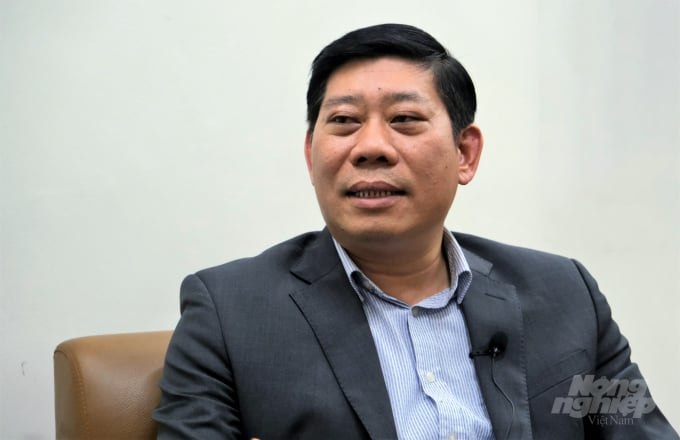
Mr. Nguyen Quang Hung shared: "Vietnam's whole fishing port system is limited by several constraints and has failed to meet demand by the provisions of the Fisheries Law and anti-IUU regulations.". Photo: Pham Hieu.
Sir, during a working visit to examine the implementation of the IUU yellow card removal in several localities, MARD Deputy Minister Phung Duc Tien several times laid stress on investing in upgrading fishing ports and regarded it as a significant solution for removing the EC's yellow card. Could you elaborate on the current state of our fishing ports?
The plan for developing the fisheries sector, including management of fishing ports, is a critical step toward achieving sustainable fisheries and committing to high levels of responsibility in international integration. Simultaneously, it contributes to Vietnam's removal of the European Commission's (EC) a yellow card for illegal, unreported, and unregulated fishing (IUU).
Vietnam's whole fishing port system is limited by several constraints and has failed to meet demand following the provisions of the Fisheries Law and anti-IUU regulations.
The Governmental Office's Decision No.1976 on the system of fishing ports and storm shelters for fishing vessels by 2020, with a view to 2030, specified that as many as 125 fishing ports must be developed, including 35 type-I fishing ports and 90 type-II fishing ports. However, six years after implementation, only three fishing ports of type I, 54 ports of type-II, and 11 ports of type III meet the criteria of the Decision.
In particular, fishing ports have yet to meet standards for attracting fishing vessels and docking frequency. It did not meet the criteria for the land and sea region immediately in front of the port, particularly the criterion for mechanization and qualified manpower resources.
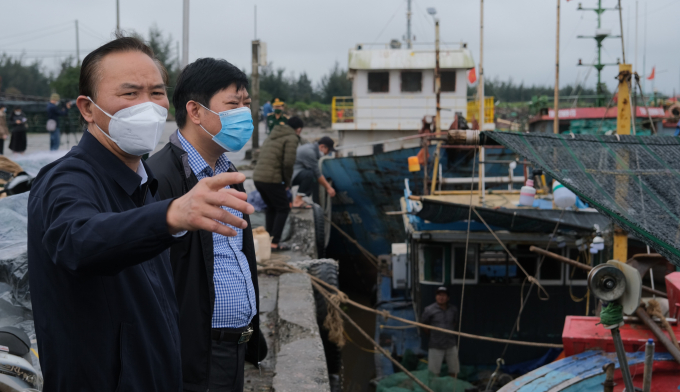
Mr. Nguyen Quang Hung accompanied Deputy Minister of Agriculture and Rural Development Phung Duc Tien to inspect the implementation of IUU yellow cards removal in coastal localities. Photo: Duc Minh.
How do you assess the shortage of qualified manpower in the management of fishing port infrastructure?
By conducting field inspections at fishing ports in 28 coastal provinces and cities, it is obvious that personnel resources are in low supply. The fishing industry's human resource is insufficient in terms of professionalism, expertise, as well as quantity, and workforce. Numerous fishing ports lack specialized seafood workers, resulting in a lack of fisheries supervision and an inability to meet regulatory standards.
As a consequence, the Directorate of Fisheries urged local governments to pay attention and allocate appropriate personnel, human and labor resources to meet management requirements. Improved attention to labor resources, in particular, at ports with a large capacity and number of fishing vessels, would result in the smooth operation of fishing ports.
Sir, what are the objective and subjective factors that contribute to the poor fishing port infrastructure?
The present fishing port infrastructure does not fulfill the demand for a variety of reasons. To begin, financial resources are limited; after more than six years of implementing Prime Minister's Decision 1976, investment in upgrading and restoring the fishing port and storm shelter system has fallen short of needs.
Second, localities spend little force to invest in upgrading fishing port infrastructure.
Third, we have not yet developed adequate policies to encourage private enterprise investment in improving the fishing port infrastructure and related services.
Last but not least, is the ineffective management of fishing port management boards and municipal fisheries management organizations.
"Type I fishing port requires the water area in front of the port is around 20 hectares, the land area is approximately 4 hectares, and mechanization is at least 90%. At the moment, only three fishing ports match the criteria for a type I fishing port, namely Ninh Co port (Nam Dinh), Phan Thiet port (Binh Thuan), and Tran De port (Soc Trang). The remaining 32 fishing ports do not match the standards and requirements set forth in the planning", Mr. Nguyen Quang Hung informed.
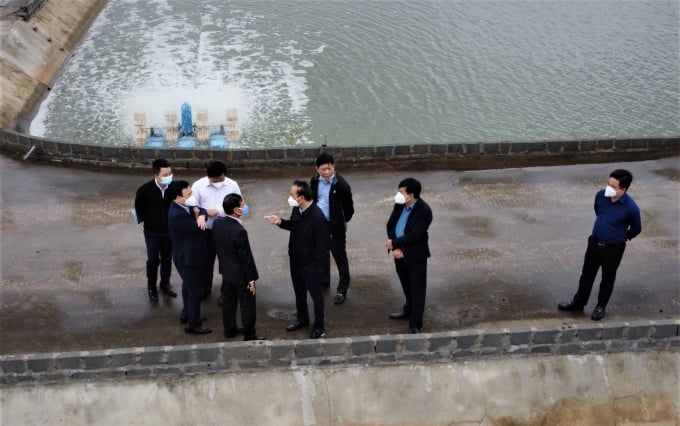
The team of the Ministry of Agriculture and Rural Development inspected the situation of fisheries development and exploitation in coastal localities. Photo: Duc Minh.
How do you evaluate the mid-and long-term resources required to upgrade fishing port infrastructure, and what are the responsibilities of the ministry, department, and local governments in allocating investment funds?
Despite the economy's general difficulties in recent years, the Government, MARD, and local governments have continued to spend resources and investment efforts to upgrade and improve fishing ports.
Between 2016 and 2020, overall investment in the fisheries industry was VND 2.4 trillion, accounting for 3.7 percent of total agricultural investment. The Government is anticipated to invest around VND 10 trillion in the next years, using medium-term capital sources as well as ODA loans for the period 2021-2025, to enhance fishing port infrastructure to satisfy practical requirements. Domestic medium-term capital is around VND 5 trillion, whereas ODA loans are approximately VND 5 trillion.
Additionally, we must change regulations to encourage private sector investment through series as well as infrastructure hiring, therefore creating spending to offset the remaining and repairing fishing ports.
Thus, what initiatives and schemes will be developed in the next years by MARD and the Directorate of Fisheries to modernize fishing port infrastructure?
Recently, the Government, through MARD, has issued several regulations aimed at promoting the fisheries industry, including those aimed at upgrading and repairing fishing ports.
However, such policies have yet to be implemented in a way that fulfills the practical necessity. Typically, financial resources are still few, and financing for fishing port repair and maintenance is limited, focused in a few provinces such as Kien Giang, Ben Tre, Nha Trang, Binh Thuan, Binh Dinh, and Quang Ninh...
To address these impediments, MARD tasked the Directorate with developing a program for designing fishing ports and storm shelters by 2030, with a goal of 2050. The initiative will design a fishing port system that complies with both the terms of the Fisheries Law and the EC's standards for removing the IUU yellow card, while also meeting the needs of regional and global fisheries organizations for fishing port management.
By 2030, a total of 152 fishing ports will be planned, with a total capital demand of approximately VND 60 trillion. Thus, fishing port systems in 28 coastal provinces and cities throughout the country will be synchronously invested to connect with transport infrastructure, local infrastructure toward industrialization, modernization, mechanization, and environmental protection, while also fully complying with fisheries control requirements.
"To date, the majority of local municipalities have not invested in maintaining, repairing, and managing the fishing port system. Funding for site clearance and dredging of canals and creeks is limited. In the coming years, localities are expected to integrate programs, projects, and priorities, as well as allocate funds for maintenance, repair, and investment in mechanization for fishing ports, based on the fisheries sector's planning and the fishing port system's planning," Mr. Nguyen Quang Hung shared.
Translated Linh Linh
![Advanced mariculture – an inevitable trend: [4] Accompanied by scientists](https://t.ex-cdn.com/nongnghiepmoitruong.vn/608w/files/sohk/2025/05/13/1941-pgsts-vo-van-nha-140958_717.jpg)
(VAN) According to Assoc. Prof. Dr. Vo Van Nha, Director of the RIA III, the development of advanced offshore mariculture is no longer an option but an essential path for Vietnam’s fisheries sector.

(VAN) Vietnam is intensifying the development of mollusk farming areas that meet international standards, aiming for sustainable growth and enhancing its export position in the global seafood market.
![Advanced mariculture – an inevitable trend: [3] Policy-driven momentum](https://t.ex-cdn.com/nongnghiepmoitruong.vn/608w/files/doanhtq/2025/05/21/0104-0616-0348-nuoi-bien-170339_789.jpg)
(VAN) To ensure the success of offshore mariculture that uses advanced technologies, it is essential to establish supportive policies that inspire both individuals and enterprises to invest with confidence.
![Advanced mariculture – an inevitable trend: [2] Outstanding results](https://t.ex-cdn.com/nongnghiepmoitruong.vn/608w/files/sohk/2025/05/12/4632-4136-nuoi-bien-11-164117_819.jpg)
(VAN) Pilot models of high-tech offshore mariculture in Vietnam, particularly in the South Central Coast region, have demonstrated exceptional economic returns and sustainability, setting a new direction for the country’s aquaculture industry.
![Advanced mariculture – an inevitable trend: [1] Moving offshore](https://t.ex-cdn.com/nongnghiepmoitruong.vn/608w/files/phucpm/2025/05/18/0252-2436-nuoi-bien-6-162148_783.jpg)
(VAN) Mariculture using advanced technology and moving offshore is an inevitable trend, as nearshore areas increasingly reveal limitations.
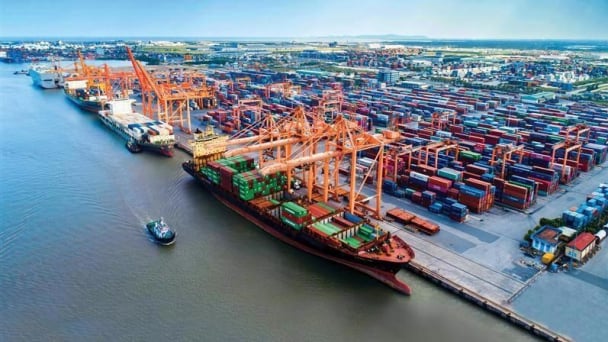
(VAN) South Korea is currently the second-largest investor in Hai Phong in terms of the number of projects (186 projects) and the largest in terms of total registered investment capital, reaching USD 14.2 billion.
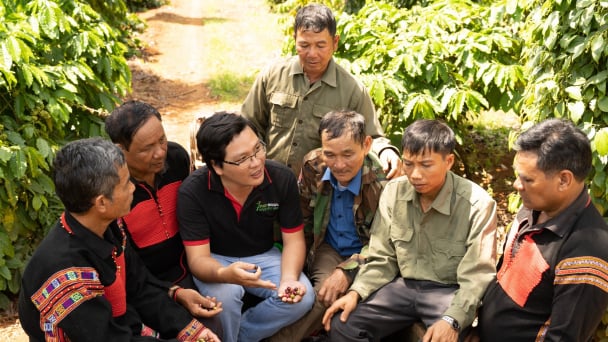
(VAN) As consumers become more environmentally conscious, legal regulations grow increasingly stringent...